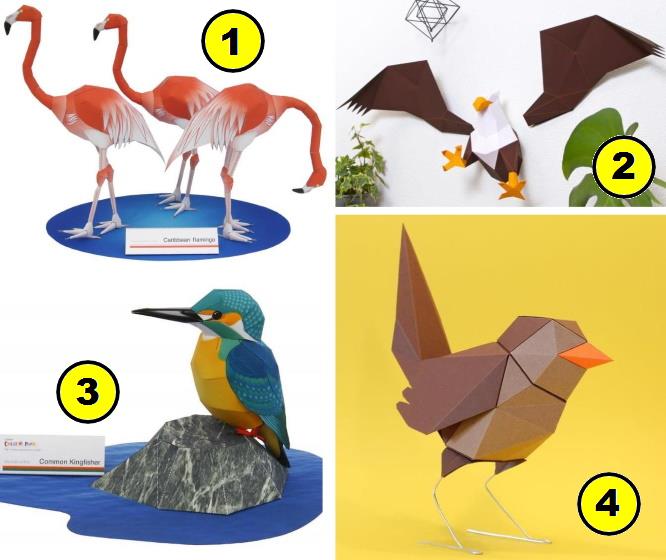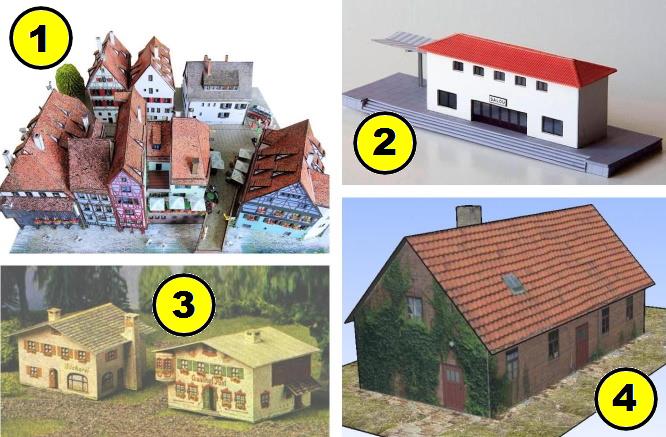Created by Swedish designer and modeler Gunnar Sillén, from the website Bildrum, this is the Majgu Island Lighthouse papercraft. The entire model occupies just one printed sheet and is in 1/160 scale (N scale).
Regarding this lighthouse, Mr. Sillén said: - "In letters and in public contexts, the name of the island is written as Magö. But on Gotland they say and write Majgu.
Since time immemorial, the island has been an important point of guidance for sailors heading to the sheltered port of Slite or other Gotland limestone loading ports such as Hide and St Olofsholm.
The island probably has had some type of lighthouse since ancient times to facilitate navigation. At the beginning of the 19th century the lighthouse was built of wood and had a barrel as a top sign on the bow and perhaps it is not so strange that they placed a barrel as the most important export from the ports of Majgu since the 17th century was quicklime delivered in wooden barrels.
In Gustaf af Klint's 1839 description for the "Atlas Sveriges Sjö" there is text about the lighthouse that describes it thus: "a tower whose buttresses in the upper two-thirds are covered with boards a few meters below the barrel which stands on top.
In 1851, the wooden lighthouse was replaced with a stepped white brick and stone structure. But still with a barrel as the top sign. And next to the lighthouse, a similar white ladder guardhouse was built for the lighthouse keepers.
The lighthouse increasingly fell into disuse during the latter part of the 20th century, as radio and radar provided new conditions for safe piloting and navigation.
In the 1980s, the lighthouse was completely destroyed.
When you visit the website to download the model, take a look at the photos. One of them shows the state of ruins the lighthouse was in at that time.
In 1990 it was rebuilt by the association of Othem Boge's home village. The Slite maritime museum is responsible for the maintenance of the lighthouse, which also uses the lighthouse with the associated cockpit as a record
The Majgu Island Lighthouse is used in the logo of the Slite Shipping Museum, a maritime museum in Slite on the east coast of the island Gotland in Sweden, a voluntary project maintained by some enthusiasts since 1998. "
In Gunnar Sillén's own words, the aim of this museum is "to collect and display objects and memories that can give some understanding about all the work that had to be done by men, women and ships to keep life going for everyone else".
In the world of miniature model making, 1/160 scale or N scale is one of the most popular scales in the model railroad hobby, which consists of building and operating model trains.
1/160 scale (N scale) has a reduction factor of 1 to 160, which means that each centimeter on the model represents 160 centimeters in real life. This results in relatively small models, allowing you to create detailed models in compact spaces.
One of the main advantages of N scale is its ability to represent realistic scenes in a reduced space. Because it is smaller than other scales, it is possible to build complex and detailed railway models even in limited areas.
Criado pelo designer e modelista sueco Gunnar Sillén, do site Bildrum, este é o papercraft do Farol da Ilha de Majgu. O modelo todo ocupa apenas uma folha impressa e está na escala 1/160 (escala N).
A respeito deste farol, o Sr. Sillén disse: - "Nas cartas e em contextos públicos, o nome da ilha é escrito como Magö. Mas em Gotland eles dizem e escrevem Majgu.
Desde tempos imemoriais, a ilha tem sido um importante ponto de orientação para os marinheiros que se dirigiam ao porto protegido de Slite ou a outros portos de carregamento de calcário de Gotland, como Hide e St Olofsholm.
A ilha provavelmente possui desde a antiguidade algum tipo de farol para facilitar a navegação. No início do século XIX o farol era construído em madeira e tinha um barril como sinal superior na proa e talvez não seja tão estranho que eles tenham colocado um barril, já que o produto de exportação mais importante dos portos de Majgu desde o século XVII era a cal virgem entregue como em barris de madeira.
Na descrição de Gustaf af Klint de 1839 para o "Atlas Sveriges Sjö" há um texto sobre o farol que o descreve assim: "uma torre cujos contrafortes nos dois terços superiores são cobertos com tábuas alguns metros abaixo do barril que fica no topo.
Em 1851, o farol de madeira foi substituído por uma estrutura de tijolo e pedra branca escalonada. Mas ainda com um barril como sinal superior. E ao lado do farol, uma guarita de escada branca semelhante foi construída para os vigilantes do farol.
O farol caiu cada vez mais em desuso durante a última parte do século 20, quando o rádio e o radar forneceram novas condições para pilotagem e navegação segura.
Na década de 1980, ele estava totalmente destruído.
Quando for visitar o site para baixar o modelo, dê uma olhada nas fotos. Uma delas mostra o estado de ruínas em que o farol se encontrava ness época.
Em 1990, ele foi reconstruído pela associação da aldeia natal de Othem Boge. O museu marítimo de Slite é responsável pela manutenção do farol, que também utiliza o farol com a cabine do piloto associada como registro
O Farol da Ilha de Majgu é usado no logotipo do Slite Shipping Museum, um museu marítimo em Slite, na costa leste da ilha Gotland, na Suécia, um projeto voluntário mantido por alguns entusiastas desde 1998."
Nas palavras do próprio Gunnar Sillén, o objetivo deste museu é "coletar e exibir objetos e memórias que podem dar alguma compreensão sobre todo o trabalho que teve de ser feito por homens, mulheres e navios para manter a vida seguindo para todos os outros".
No mundo do modelismo em miniatura, a escala 1/160 ou escala N é uma das escalas mais populares no hobby do ferromodelismo, que consiste em construir e operar maquetes de trens.
A escala 1/160 (escala N) possui um fator de redução de 1 para 160, o que significa que cada centímetro no modelo representa 160 centímetros na vida real. Isso resulta em modelos relativamente pequenos, permitindo a criação de maquetes detalhadas em espaços compactos.
Uma das principais vantagens da escala N é a sua capacidade de representar cenas realistas em um espaço reduzido. Por ser menor que outras escalas, é possível construir maquetes ferroviárias complexas e detalhadas mesmo em áreas limitadas.
Link: Majgu.Island.Lighthouse.Paper.Model.In.1/160.Scale.by.Gunnar.Sillén
More Architectural Paper Models in 1/160 Scale related posts:





























